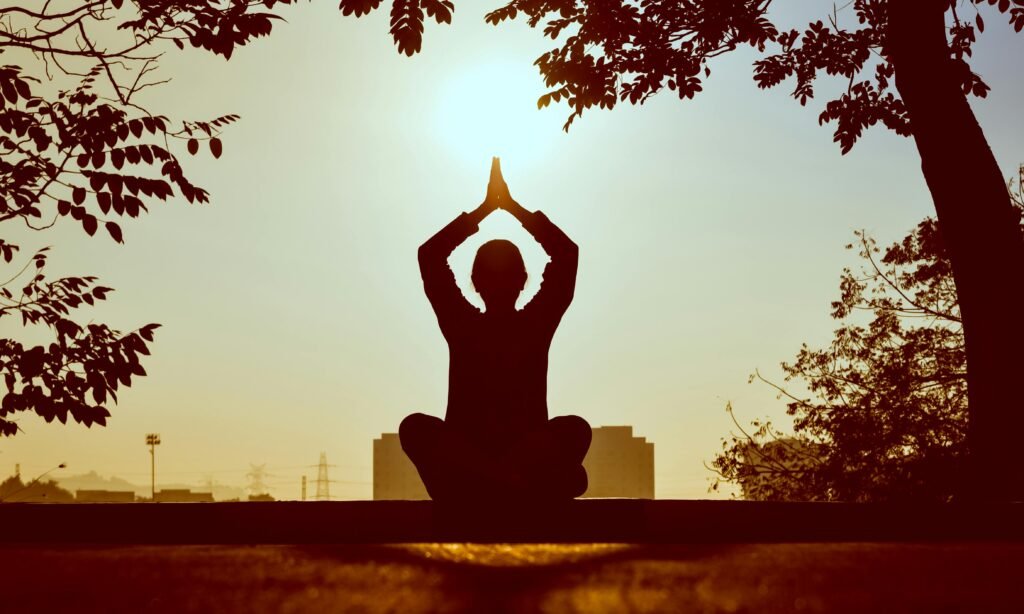Have you ever thought about why some yoga classes feel more real and helpful than others?
Language is often the key. To get deeper into your practice and feel more linked, you need to learn Sanskrit, the ancient language of yoga. It’s like chanting the names of poses the way they were meant to be said, with each word carrying spiritual meaning and ancient knowledge. Want to know how this can change your yoga journey?
Table of Contents
Learn the old secrets of yoga by doing Sanskrit yoga poses. Get deeper into your practice, become more mindful,. Are you ready to change your path? Let's start!
The Significance of Sanskrit in Yoga
Sanskrit is more than just a language. It is called “the language of the gods” for a reason. To the spiritual and intellectual depths of yoga, it’s like a bridge. Each pose, or “asana,” has a name in Sanskrit that helps you understand and be more aware.

Why Learn Sanskrit Yoga Poses?
You can connect with the practice’s ancient roots by learning yoga moves in Sanskrit. It makes your routine more real and interesting, which makes the experience deeper and more important.
Understanding Sanskrit Yoga Poses
The Historical Context of Sanskrit in Yoga
Many of India’s classical books, such as the Vedas and Upanishads, were written in Sanskrit thousands of years ago. Sanskrit is used in these works about yoga to explain the theory and techniques that are essential to the practice.
The Language of Yoga: Sanskrit Basics
Since Sanskrit is a phonetic language, once you grasp the fundamentals, pronouncing it correctly is easy. Every position name offers a glimpse into the essence of the practice by describing the physical form or intended effect.

Key Benefits of Knowing Sanskrit Yoga Poses
Enhancing Your Practice
You can speak more effectively if you know the Sanskrit names, especially in different yoga communities. It provides a global language that crosses the barriers between various educational traditions and techniques.
Deepening Your Understanding
Sanskrit names frequently allude to the mythology or deeper meaning of the position. This knowledge can provide you with context and a link to the larger yoga tradition, which can motivate and enhance your practice.

Popular Sanskrit Yoga Poses
Tadasana (Mountain Pose)
A foundational pose that promotes stability and balance. Standing tall like a mountain, this pose helps align the body and mind.
Adho Mukha Svanasana (Downward-Facing Dog)
A revitalizing posture that stretches the whole body and improves flexibility and strength. It’s a basic in a lot of yoga poses.
Virabhadrasana I (Warrior I Pose)
This powerful stance embodies strength and courage, named after the fierce warrior Virabhadra from Hindu mythology.
Trikonasana (Triangle Pose)
A pose that combines strength, balance, and flexibility. It stretches the legs and torso, opens the hips, and strengthens the core.
Balasana (Child’s Pose)
A restful pose that promotes relaxation and introspection. It’s often used as a counterpose to more strenuous asanas.

Sanskrit Poses for Beginners
Sukhasana (Easy Pose)
A simple seated position perfect for meditation and breathing exercises. It encourages a straight spine and relaxed shoulders.
Vajrasana (Thunderbolt Pose)
Often used for meditation and pranayama, this kneeling pose is said to be as strong as a thunderbolt.
Bhujangasana (Cobra Pose)
A gentle backbend that strengthens the spine and opens the chest, ideal for beginners working on flexibility.

Intermediate Sanskrit Yoga Poses
Utkatasana (Chair Pose)
A challenging pose that builds strength in the legs and core. It simulates sitting in an invisible chair.
Garudasana (Eagle Pose)
This balancing pose stretches the shoulders and hips while improving focus and concentration.
Natarajasana (Dancer Pose)
A graceful balancing pose that stretches the chest, shoulders, and legs, enhancing poise and stability.

Advanced Sanskrit Yoga Poses
Sirsasana (Headstand)
Often called the king of asanas, this inversion requires strength, balance, and concentration.
Mayurasana (Peacock Pose)
A challenging arm balance that strengthens the wrists, forearms, and core. It requires considerable practice and precision.
Bakasana (Crow Pose)
An arm balance that demands strength and focus. It strengthens the arms, wrists, and abdominal muscles.

The Role of a Yoga Instructor in Teaching Sanskrit Poses
Finding a Qualified Instructor
Look for teachers who integrate Sanskrit into their lessons and stress its significance. Their knowledge can greatly improve your study.
The Importance of Proper Guidance
Proper pronunciation and understanding are crucial. A qualified instructor can provide the necessary corrections and insights.
Resources for Learning More About Sanskrit Yoga Poses
Books and Guides
Invest in reputable books that offer detailed explanations of poses and their Sanskrit names.
Online Classes and Tutorials
Utilize online platforms that offer courses and videos dedicated to learning Sanskrit yoga poses.
Conclusion
Taking up Sanskrit yoga poses can revolutionize your practice by providing more profound understanding and a closer bond with the ancient origins of yoga. Remember that learning is a process that happens gradually, and that every step you take will bring you one step closer to a deeper comprehension.
FAQ
Most frequent questions and answers
Learning poses in Sanskrit connects you to the traditional roots of yoga, enhancing the depth and authenticity of your practice.
Not necessarily. With practice and proper guidance, learning Sanskrit names can be as straightforward as learning English ones.
Use online resources, listen to native speakers or experienced instructors, and practice regularly to master the correct pronunciation.
Absolutely! Starting with basic poses and gradually learning their Sanskrit names can be a rewarding experience for beginners.








Average Rating